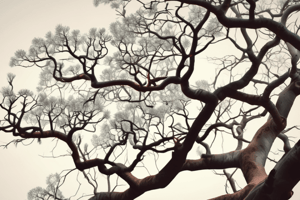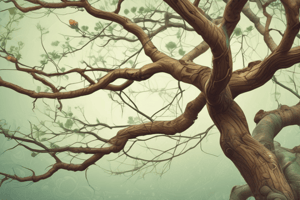Podcast
Questions and Answers
The study of the chemical processes within living organisms is known as Ecology.
The study of the chemical processes within living organisms is known as Ecology.
False (B)
A prokaryotic cell possesses a nucleus, which contains the cell's DNA.
A prokaryotic cell possesses a nucleus, which contains the cell's DNA.
False (B)
Natural selection is the process of random changes in gene frequencies within a population, leading to evolution.
Natural selection is the process of random changes in gene frequencies within a population, leading to evolution.
False (B)
Flashcards are hidden until you start studying
Study Notes
Branches of Biology
- Botany: study of plants
- Zoology: study of animals
- Microbiology: study of microorganisms
- Ecology: study of interactions between organisms and their environment
- Biochemistry: study of chemical processes in living organisms
- Molecular Biology: study of structure and function of biomolecules
- Genetics: study of heredity and variation
- Evolutionary Biology: study of evolution of species
- Biophysics: study of physical principles underlying biological processes
Cells
- Basic unit of life
- Composed of:
- Cell membrane: semi-permeable membrane separating cell from environment
- Cytoplasm: jelly-like substance inside cell membrane
- Nucleus: control center of cell containing DNA
- Mitochondria: site of cellular respiration
- Ribosomes: site of protein synthesis
- Cell types:
- Prokaryotic: lacks nucleus (e.g. bacteria)
- Eukaryotic: has nucleus (e.g. plants, animals)
Genetics
- Inheritance of traits:
- Mendel's laws:
- Law of segregation: each trait separates from others during gamete formation
- Law of independent assortment: traits are inherited independently
- Mendel's laws:
- DNA structure:
- Double helix model
- Composed of nucleotides (A, C, G, T)
- Gene expression:
- Transcription: DNA to RNA
- Translation: RNA to protein
Evolution
- Change in species over time
- Mechanisms:
- Natural selection: adaptation to environment
- Genetic drift: random change in gene frequency
- Mutation: change in DNA sequence
- Gene flow: movement of genes between populations
- Evidence:
- Fossil record
- Comparative anatomy
- Molecular biology
Ecosystems
- Interactions between organisms and environment
- Components:
- Biotic factors: living organisms
- Abiotic factors: non-living components (e.g. light, temperature, water)
- Energy flow:
- Producers: autotrophs (e.g. plants)
- Consumers: heterotrophs (e.g. animals)
- Decomposers: break down organic matter
- Ecosystem services:
- Provisioning (e.g. food, water)
- Regulating (e.g. climate, disease)
- Cultural (e.g. recreation, spiritual)
Branches of Biology
- Botany focuses on plants, encompassing their structure, growth, and ecology.
- Zoology examines animals, including behavior, physiology, and classification.
- Microbiology involves the study of microorganisms, such as bacteria, viruses, and fungi.
- Ecology explores the interactions between organisms and their environment, including ecosystems and biomes.
- Biochemistry investigates the chemical processes and substances within living organisms.
- Molecular Biology analyzes the structure, function, and interactions of biomolecules like DNA and proteins.
- Genetics studies heredity, variation, and the molecular basis of traits in organisms.
- Evolutionary Biology delves into the changes in species over time and the mechanisms driving these changes.
- Biophysics applies physical principles to biological systems, studying how physical forces affect biological processes.
Cells
- Cells are the fundamental units of life, serving as the building blocks for all living organisms.
- The cell membrane functions as a semi-permeable barrier that regulates the movement of substances in and out of the cell.
- Cytoplasm is the viscous substance within the cell membrane where various cellular processes occur.
- The nucleus is the cell's control center, housing genetic material (DNA) essential for cell function and reproduction.
- Mitochondria are known as the "powerhouses" of the cell, responsible for producing energy through cellular respiration.
- Ribosomes play a crucial role in protein synthesis by translating genetic information into proteins.
- Prokaryotic cells lack a nucleus and organelles; examples include bacteria.
- Eukaryotic cells contain a nucleus and organelles, including plant and animal cells.
Genetics
- Inheritance of traits follows Mendel's laws, providing a foundation for understanding genetics.
- The Law of Segregation states that alleles for each trait separate during gamete formation, ensuring diversity in offspring.
- The Law of Independent Assortment indicates that different traits are inherited independently of one another.
- DNA is structured as a double helix, composed of nucleotides featuring the bases adenine (A), cytosine (C), guanine (G), and thymine (T).
- Gene expression consists of two main processes: transcription (converting DNA to RNA) and translation (converting RNA to protein).
Evolution
- Evolution refers to the gradual change in species over time, driven by various mechanisms.
- Natural selection leads to adaptation, where advantageous traits become more common in a population.
- Genetic drift entails random fluctuations in gene frequencies, impacting small populations significantly.
- Mutations introduce changes in DNA sequences, contributing to genetic diversity and sometimes leading to new traits.
- Gene flow occurs when genes are transferred between populations, affecting genetic diversity.
- Evidence supporting evolution includes the fossil record, which documents changes in species, comparative anatomy, showing similarities among related species, and molecular biology, which examines genetic relationships.
Ecosystems
- Ecosystems consist of interactions among organisms and between organisms and their physical environment.
- Biotic factors encompass all living components, including plants, animals, and microorganisms.
- Abiotic factors consist of non-living elements such as light, temperature, and water, which influence ecosystem dynamics.
- Energy flows through ecosystems, starting with producers (autotrophs like plants), followed by consumers (heterotrophs like animals), and ending with decomposers that recycle organic matter.
- Ecosystem services are vital functions provided by natural systems, classified into:
- Provisioning services (e.g., food and water)
- Regulating services (e.g., climate control and disease regulation)
- Cultural services (e.g., recreational and spiritual benefits)
Studying That Suits You
Use AI to generate personalized quizzes and flashcards to suit your learning preferences.




